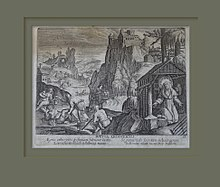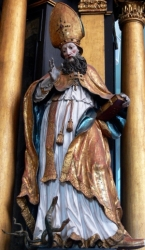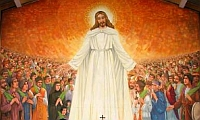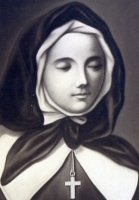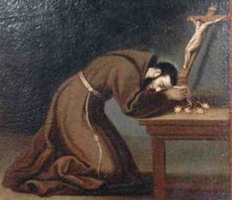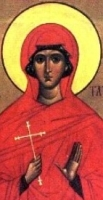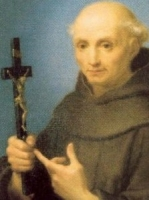Bl. Yvette
Feastday: January 13
Patron: of brides, large families, and widows
Birth: 1158
Death: 1228
Blessed Yvette has not been canonized, but she is considered a saint. Blessed Yvette (Jutta of Huy), Widow (Feast day - January 13) Endowed with extraordinary charisms, Yvette was a product of the development of mysticism in the Low Countries in the thirteenth century. In this she joined a select number of young women Christians such as Juliana of Cornillion, Eve of St. Martin, Isabel of Huy, Mary of Oingnies, Ida of Leau, Ida of Nivelles, Ida of Loviano, Christiana of St.-Trend, Lutgard of Tongres, and Margaret of Ypres.
She was born of a wealthy family of Huy near Liege in 1158 and when very young was married off by her parents. Five years and three children later, she was a widow at the youthful age of eighteen. There was no dearth of suitors, drawn by her uncommom beauty, but Yvette would have none of them. She dedicated herself for eleven years to caring for lepers out of surpassing love for God.
For the last thirty-six years of her life, the holy woman lived as an anchoress and had many mystical experiences. Her prayers and miracles made her famous. She succeeded in bringing her father and one of her two remaining children back to the Faith and solicitously aided the countless people who flocked to consult her in her hermitage. She died on January 13, 1228.
Yvette of Huy (1158 – 13 January 1228) was a venerated Christian prophet and anchoress. Born in Huy, Belgium, she was also known as Ivette, Ivetta, Jufta or Jutta.[1][2]
Life
Yvette was born into a wealthy, but not particularly religious family, close to the bishop of Liège. From an early age Yvette was hesitant of marriage and wished to live a religious life. [1] Her father was a tax collector.[3] However, Yvette was forced into an arranged marriage at aged thirteen. Her marriage produced three children (one died while still an infant) before she was widowed at eighteen. Like many medieval women, it was in widowhood that she gained more self-determination. She began to live a more religious life by attending mass regularly, giving to the poor, and deciding not to remarry. Her father objected to the latter two activities. He was so concerned about her excessive giving to the poor that he took her sons from her, fearing that she would give away all of their wealth. Her father and others in her family also tried to get her to remarry. He even took her to the Bishop of Leige, for whom he worked, but Yvette's Hagiography attests that when the bishop saw her devotion and humility he agreed to let her stay in holy widowhood. It was after this assurance from the Bishop that Yvette retired to a virtually derelict leper hospital in Statte, close to Huy, on the heights of the river Meuse to tend to the inmates, and more fully follow her religious calling.[1] She left her two sons in the care of their grandfather.
Ten years later, she became an anchoress and was enclosed in a chapel cell near the colony in a ceremony conducted by the abbot of Abbaye Notre-Dame d'Orval. From there she offered guidance to pilgrims who considered her a prophetess in the apostolic sense of having insight into the divine. She summoned priests and even the dean of the local church to her presence and confronted them about their behaviour. She was responsible for the conversion of her father and one of her two surviving sons. After a time, her power threatened the male clergy and canons. She was denounced.[3] Yvette died on 13 January 1228 in Huy, Belgium.
Her life was recorded by the Premonstratensian Hugh of Floreffe.[2] Although never formally canonised as a saint, she is classed as ‘blessed’ by the Catholic Church; feast day January 13th, the date of her death. One of her sons became a monk at the monastery of Orval and became its abbot. In time he too became classed as a ‘blessed': Eustachius of Huy, commemorated on March 13th in the Cistercian calendar.
Feast of the Baptism of the Lord
Also known as
Baptism of Christ
Memorial
• 1st Sunday after Epiphany (declared by Pope Paul VI)
• formerly celebrated on Epiphany
Profile
Commemorates the baptism of Jesus in the River Jordan by Saint John the Baptist.
Saint Hilary of Poitiers
பாய்ட்டியர்ஸ் நகர் புனிதர் ஹிலாரி
ஆயர், ஒப்புரவாளர், மறை வல்லுநர்:
பிறப்பு: கி.பி. 310
பிக்டாவியம், கௌல் (தற்போதைய பொய்ட்டியர்ஸ், ஃபிரான்ஸ்)
இறப்பு: கி.பி. 367
பாய்ட்டியர்ஸ்
ஏற்கும் சமயம்:
ரோமன் கத்தோலிக்க திருச்சபை
கிழக்கு மரபுவழி திருச்சபை
ஆங்கிலிக்கன் சமூகம்
லூதரன் திருச்சபை
ஓரியண்டல் மரபுவழி திருச்சபை
நினைவுத் திருநாள்: ஜனவரி 13
பாய்ட்டியர்ஸ் நகர புனிதர் ஹிலாரி, “பாய்ட்டியர்ஸ்” (Bishop of Poitiers) மறை மாவட்ட ஆயரும், திருச்சபையின் “மறை வல்லுனரும்” (Doctor of the Church) ஆவார். இவர் "ஆரியன் இனத்தவரின் சுத்தியல்" (Hammer of the Arians) என்றும், "மேற்கின் அதானாசியஸ்" (Athanasius of the West) என்றும் அழைக்கப்படுகின்றார். இலத்தீன் மொழியின்படி, இவரது பெயருக்கு “மகிழ்ச்சி” அல்லது “சந்தோசம்” என்றும் பொருள்படும்.
பாய்ட்டியர்ஸ் நகரில் நான்காம் நூற்றாண்டின் ஆரமபத்தில் பிறந்த இவருடைய பெற்றோர் வேறுபட்ட சபையின் "பாகன்" இனத்தவர் ஆவர். கிரேக்க மொழி உள்ளிட்ட பாகன் கல்வி இவருக்கு தரப்பட்டது. பின்னர் இவர் கற்ற பழைய மற்றும் புதிய ஏற்பாடுகளைப் பற்றிய கல்வி, இவர் கொண்டிருந்த "3ம் நூற்றாண்டில் பிலாண்டினஸ் பின்பற்றுபவர்கள் உருவாக்கிய ஒரு தத்துவ மற்றும் சமய அமைப்பு" (Neo-Platonism) கிறிஸ்தவத்திற்காக கைவிட நேர்ந்தது. பின்னர் அவர், தமது மனைவி, மற்றும் பாரம்பரியப்படி, “புனித அப்ரா” (Saint Abra) எனும் தமது மகளுடன் திருமுழுக்கு பெற்று திருச்சபையில் இணைந்தார்.
அக்காலத்தில், கி.பி. சுமார் 350ம் ஆண்டு, அல்லது 353ம் ஆண்டு, பாய்ட்டியர்ஸ் நகர மக்கள் ஹிலாரியை மிகவும் மதித்தனர். அவர்கள் அவரை தமது ஆயராக மறைமுகமாக தேர்ந்துகொண்டனர். அக்காலத்தில், மேற்கத்திய திருச்சபையை ஆரியனிசம் (Arianism) கைப்பற்றும் அச்சுறுத்தல் இருந்தது.
இந்த இடையூறுகளைத் தடுக்க ஹிலாரி நடவடிக்கை மேற்கொண்டார். “சடுர்நினஸ்” ((Saturninus) எனும், "ஆர்லஸ்" என்ற மறைமாவட்டத்தின் ஆரியன் ஆயர், (The Arian Bishop of Arles) மற்றும் அவரது ஆதரவாளர்களான "யுர்சாசியஸ் மற்றும் வலேன்ஸ்" (Ursacius and Valens) ஆகிய மரபுவழி திருச்சபைக் கிறிஸ்தவர்களின் "கல்லிசன் தலைமைக் குருக்களைக்கொண்டு" (Gallican hierarchy) திருச்சபையைக் காக்க அவர் முதல் நடவடிக்கை எடுத்தார்.
இதே காலகட்டத்தில், ஆரியர்கள் தமது எதிர்ப்பாளர்களை நசுக்க வேண்டி செய்யும் துன்புருத்தல்களைக் கண்டித்து, பேரரசர் “இரண்டாம் காண்ஸ்டன்ஷியசுக்கு" (Emperor Constantius II) ஹிலாரி ஒரு கண்டன கடிதம் எழுதினர். சரித்திர வல்லுனர்கள் இதனை, நடைமுறையில் சில பாகங்களே உள்ள (Book Against Valens) என்று குறிப்பிடுகின்றனர். இம்முயற்சிகள் ஹிலாரிக்கு முதலில் வெற்றியைத் தரவில்லை.
வனவாசத்திற்கான காரணங்கள் மறைத்தே வைக்கப்பட்டிருந்தன என்றாலும், ஹிலாரி ஏறத்தாழ நான்கு வருடங்கள் வெளிநாட்டில் செலவிட்டார். அதானாசியுஸின் கண்டனம் மற்றும் (Nicene) மீதான விசுவாசத்தை அவர் ஏற்க மறுத்ததாலேயே அவர் நாடு கடத்தப்பட்டதாக தகவல்கள் உறுதி செய்கின்றன.
நான்கு வருட வெளிநாட்டு வாசத்தின் பின்னர், 361ம் ஆண்டு, சொந்த மறைமாவட்டம் திரும்பிய ஹிலாரி, முதல் இரண்டு அல்லது மூன்று வருடங்களின் பெரும்பகுதியை உள்ளூர் மத குருமார்களை சமாதானப்படுத்துவதில் செலவிட்டார்.
சுமார் 360ம் ஆண்டு, ஹிலாரியின் ஊக்குவிப்பால் "டூர்ஸ்" மறைமாவட்டத்தின் பதவியேற்கவிருந்த ஆயர் மார்ட்டின் (Martin, the future bishop of Tours), "லிகுக்" (Ligugé) என்ற இடத்தில் ஒரு துறவு மடம் ஒன்றினை நிறுவினார்.
புனிதர் ஜெரோம் (St. Jerome) அவர்களின் கூற்றுப்படி, கி.பி. 367ம் ஆண்டு, பாய்ட்டியர்ஸ் நகரில் ஹிலாரி மரித்தார்.
Also known as
• Athanasius of the West
• Doctor of the Divinity of Christ
• Hammer against Arianism
• Ilario di Poitiers
• Malleus Arianorum
Profile
Born to wealthy polytheistic, pagan nobility, Hilary's early life was uneventful as he married, had children (including Saint Abra), and studied on his own. Through his studies he came to believe in salvation through good works, then monotheism. As he studied the Bible for the first time, he literally read himself into the faith, and was converted by the end of the New Testament.
Hilary lived the faith so well he was made bishop of Poitiers, France from 353 to 368. Hilary opposed the emperor's attempt to run Church matters, and was exiled; he used the time to write works explaining the faith. His teaching and writings converted many, including Saint Florence of Poitiers, and in an attempt to reduce his notoriety he was returned to the small town of Poitiers where his enemies hoped he would fade into obscurity. His writings continued to convert pagans.
He introduced Eastern theology to the Western Church, fought Arianism with the help of Saint Viventius, and was proclaimed a Doctor of the Church in 1851.
Born
315 at Poitiers, France
Died
368 of natural causes
Patronage
• against rheumatism
• against snakes
• against snake bites
• backward children
• children learning to walk
• mothers
• sick people
• 4 cities
Representation
• dragon
• serpent
• stick
• pen
• child
Blessed Francesco Maria Greco
Profile
Born to a pious family, the son of a pharmacist, he received early religious training from his mother. Though his father hoped Francesco would take over the family business, the boy felt a call to the priesthood, studied in Naples, Italy, and was ordained in the archdiocese of Cosenza-Bisignano, Italy on 17 December 1881. Parish priest at the church of Saint Nicholas in Acri, Italy through 1887; while there he organized the construction of the Caritas hospital. Diocesan archpriest in 1888. Professor of theology. Believing that anyone who understood the faith would follow the faith, Monsignor Francesco concentrated on teaching, evangelizing and catechizing the young, and setting up training for new catechists. In 1892-1893, with Sister Maria Teresa de Vincenti, he founded the Little Workers of the Sacred Hearts who continue their good work with today with the poor and abandoned in Albania, Argentina, Africa, Jamaica, Italy, India, the Holy Lands and the United States.
Born
26 July 1857 in Acri, Cosenza, Italy
Died
• 13 January 1931 in Acri, Cosenza, Italy of bronchitis
• re-interred on 19 May 1961 following an exhumation as part of the canonization process
Beatified
• 21 May 2016 by Pope Francis
• beatification recognition celebrated at Cosenza, Italy, Cardinal Angelo Amato chief celebrant
• the beatification miracle involved bringing Nina Pancaro out of a coma in which she had lapsed following a severe illness and surgery; while comatose, she was visited by a dream of Father Francesco who healed her and woke her up
Patronage
Little Workers of the Sacred Hearts
Saint Kentigern
Also known as
• Kentigern of Glasgow
• Kentigern Garthwys
• Kentigern Mungo
• Kentigern of Elwy
• Cantigernus, Chentingerno, Cyndeyrn, Kentigernus, Kintigern, Mahoe, Mochaoi, Mochua, Mungho, Mungo
Profile
Grandson of the British prince Lothus; son of Saint Theneva. Hermit. Monk. Missionary to Scotland, beginning at Cathures. Bishop of the Strathclyde Britons in the area of modern Glasgow in 540. He taught and led there for 13 years, living in great austerity. Exiled in 553 during an anti-Christian uprising by local pagans, he fled to Menevia, Wales, where he stayed with Saint David of Wales. He founded a monastery at Llanelwy, and served as its first abbot. He returned to Scotland in 573, evangelizing the areas of Galloway and Cumberland. He returned to Glasgow in 581 and led his people there for his remaining 22 years. Apostle to northwest England and southwest Scotland.
Glasgow's Coat of Arms includes a bird, a fish, a bell and a tree, the symbols of Kentigern.
• The Bird commemorates the pet robin owned by Saint Serf, which was accidentally killed by monks who blamed it on Saint Kentigern. Saint Kentigern took the bird in his hands and prayed over it, restoring it to life.
• The Fish was one caught by Saint Kentigern in the Clyde River. When it was slit open, a ring belonging to the Queen of Cadzow was miraculously found inside it. The Queen was suspected of intrigue by her husband, and that she had left with his ring. She has asked Saint Kentigern for help, and he found and restored the ring in this way to clear her name.
• The Bell may have been given to Saint Kentigern by the Pope. The original bell, which was tolled at funerals, no longer exists and was replaced by the magistrates of Glasgow in 1641. The bell of 1641 is preserved in the People's Palace.
• The Tree is symbol of an incident in Saint Kentigern's childhood. Left in charge of the holy fire in Saint Serf's monastery, he fell asleep and the fire went out. However he broke off some frozen branches from a hazel tree and miraculously re-kindled the fire.
Born
c.518 at Culross, Fife, Scotland
Died
• 13 January 603 in Glasgow, Scotland of natural causes
• relics in the crypt of the Kentigern cathedral, Glasgow
Patronage
• Glasgow, Scotland
• salmon
Representation
• bell
• bird
• clock
• fish
• ring
• robin
• salmon
• tree
• trees
Saint Remigius of Rheims
Also known as
• Apostle of the Franks
• Remigius of Reims
• Remi, Remigio, Remigiusz, Romieg, Rémi, Rémy
Profile
Born to the Gallo-Roman nobility, the son of Emilius, count of Laon, and of Saint Celina; younger brother of Saint Principius of Soissons; uncle of Saint Lupus of Soissons. A speaker noted for his eloquence, he was selected bishop of Rheims (in modern France) at age 22 while still a layman, and served his diocese for 74 years. He evangelized throughout Gaul, working with Saint Vaast. Spiritual teacher of Saint Theodoric. Converted Clovis, king of the Franks, baptising him on 24 December 496; this opened the way to the conversion of all the Franks and the establishment of the Church throughout France. Blind at the time of his death.
Born
c.438
Died
• 13 January 533 of natural causes
• interred on 15 January 533
• relics transferred to the Basilica Saint-Rémy 1 October 1049
Canonized
1049 by Pope Saint Leo IX
Patronage
• against epidemics
• against fever
• against plague
• against religious indifference
• against snakes
• against throat pain
• France
• Rheims, France, archdiocese of
• Rheims, France, city of
Blessed Veronica of Milan
மிலன்நகர்_அருளாளர்_வெரோனிக்கா
(1445-1497)
ஜனவரி 13
இவர் (#BlVeronicaOfMilan) இத்தாலியில் உள்ள பினஸ்கோ என்றொரு சிற்றூரில் பிறந்தவர்.
இவரது குடும்பம் விவசாயக் குடும்பம். அதனால் இவர் தன் வீட்டுத் தோட்டத்தில் வேலை பார்த்து வந்தார். குடும்பத்தில் நிலவிய வறுமையின் காரணமாக இவரால் பள்ளிக்குச் சென்று படிக்க முடியவில்லை.
இதுவொரு பக்கம் என்றால், இன்னொரு பக்கம் இவர் ஆண்டவர்மீது ஆழமான நம்பிக்கை கொண்டு வாழ்ந்து வந்தார். இவர் இயேசு மற்றும் மரியாவினுடைய காட்சிகளை அடிக்கடி கண்டார். ஒருமுறை மரியா இவருக்குத் தோன்றி, நல்ல எண்ணத்தோடு வாழ வேண்டும் என்றும், அடுத்தவரைப் பற்றிப் புறங்கூறக் கூடாது என்றும், இயேசுவின் பாடுகளைப் பற்றித் தியானிக்க வேண்டும் என்றும் சொல்லிவிட்டு சென்றார்.
இவருக்கு 22 வயது நடக்கும்போது பொது நிலையினருக்காக புனித அகுஸ்தினினின் சபையில் சேர்ந்து, மக்களிடமிருந்து யாசித்து உண்டு வந்தார். மேலும் இவர் சபையின் வளர்ச்சிக்காகப் பலரிடமும் உதவி வேண்டிச் சென்றார். 1494 ஆம் ஆண்டு இயேசு இவருக்கு ஒரு காட்சி கொடுத்தார். அக்காட்சியில் இயேசு இவரிடம் திருத்தந்தை ஐந்தாம் அலெக்சாண்டரிடம் ஒரு செய்தியைச் சொல்ல அனுப்பி வைத்தார். அவ்வாறு இவர் திருத்தந்தையிடம் சென்று, இயேசு சொன்ன செய்தியைச் சொல்லிவிட்டுத் திரும்பும் வழியில் இறையடி சேர்ந்தார்.
இவருக்கு திருத்தந்தை ஒன்பதாம் பெனடிக்ட் 1749 ஆம் ஆண்டு அருளாளர் பட்டம் கொடுத்தார்.
Also known as
Veronica of Binasco
Additional Memorial
28 January (Augustinian calendar)
Profile
Grew up in a poor peasant family in a small village, doing chores and working the fields. She had no formal education, and tried unsuccessfully to teach herself to read at night. She began to have religious ecstasies, visions of the life of Christ, and was taught her catechism by the Virgin Mary. Our Lady explained it in the form of three mystical letters, one that signified purity of intention, the second abhorrence of complaining, and the third a reminder to daily meditate on the Passion. Augustinian lay-sister at the convent of Saint Martha, Milan, Italy, at age 22, being instructed for three years before she was allowed to join. Assigned to beg alms in the street for the support of the house. She suffered alternating bouts of intense physical pain and religious ecstacies for years. She received a vision of Christ in 1494, and was given a message for Pope Alexander VI; she made a journey to Rome, Italy to deliver it. Following a six-month illness, she died on the date she had prophesied.
Born
c.1445 at Binasco, Italy, a small village near Milan
Died
13 January 1497 in Milan, Italy of natural causes
Beatified
• 1517 by Pope Leo X (cultus confirmed)
• 1672 by Pope Clement X (devotion extended to the entire Augustinian Order)
• 1749 by Pope Benedict XIV (added to Roman Martyrology)
Patronage
Binasco, Italy
Blessed Ivetta of Huy
Also known as
• Ivetta of Liege
• Ivette, Juette, Jufta, Jutta, Yvette
Profile
Born to family that was wealthy but indifferent to the faith. Forced into an arranged marriage at age 13. Mother of three, though one died in childhood. Widowed at age 18. She turned away all suitors to care for lepers for eleven years while she raised her children. Had an ongoing dispute with her father over her charitable spending, which he considered excessive. With her children grown, she retired from the world to become an anchoress her remaining years. Had mystical gifts including the ability to read hearts and visions of distant events. Miraculously received Communion. Converted her father and one of her children.
Born
1158 at Huy, Belgium
Died
13 January 1228 at Huy, Belgium, of natural causes
Patronage
• brides
• parents of large families
• widows
Representation
• woman in an ecstasy in a hut
• woman in religious habit with a red-hot tripod nearby
• woman in widow's weeds
• woman tending to lepers
Blessed Emil Szramek
Also known as
Emilio
Additional Memorial
12 June as one of the 108 Martyrs of World War II
Profile
Priest in the archdiocese of Katowice, Poland, simultaneously serving as pastor of the parish of Saint Mary in Katowice, and chancellor of the diocesan curia. Along with being a strong spiritual leader, Father Emil was an historian, specializing in his native Silesia. He wrote on a number of topics including history, social issues, ethnography, theology and literature.
On 8 April 1940 he was arrested by the occupying Nazis and over the course of several months he was imprisoned, harassed and tortured in concentration camps in Gusen, Mauthausen and Dachau. He was a particular target for the guards as he never broke, and spent his time ministering to other prisoners. Martyr.
Born
29 September 1887 in Tworków, Slaskie, Poland
Died
13 January 1942 in the prison camp of Dachau, Oberbayern, Germany by having a series of ice-cold streams of water dumped on him till he died of shock and exposure
Beatified
13 June 1999 by Pope John Paul II
Saint Agrecius of Trier
Also known as
• Agricius of Trier
• Agritius of Trèves
• Agrice, Aguy
Profile
Nothing reliable is recorded about his life before his service to the Church. Patriarch of Antioch. Friend and advisor to empress Saint Helena. Named bishop of Treves, Gaul (modern Trier, Germany) by Pope Sylvester I; served for 20 years. Attended the Council of Arles in 314. Built many churches in the diocese, and made provision for the Relics of Trier, which were collected by Saint Helena during her travels through the Holy Lands. Saint Maximus and Saint Paulinus taught in Agrecius's schools, and he was acquainted with Saint Athanasius. Because of his association with several saints and with the relics of others, he became the subject of much pious fiction.
Born
Syrian
Died
335 of natural causes
Saint Vivenzio of Blera
Also known as
Viventius
Additional Memorials
• Easter Monday (pilgrimage to his hermitage)
• 2nd Sunday in May (pilgrimage to his hermitage)
• 11 December (Blera, Italy)
Profile
Priest. Bishop of Blera, Italy from 457 to 484. Noted for his vocal opposition to the pagan and corrupt local nobility. Some of them bribed Vivenzio's servants to put women's clothing in his chambers in order to accuse him of illicit relations. Vivenzio denied any wrong-doing, then moved to a nearby cave in order to do penance for the sins of his accusers. He lived there for seven years in prayer and fasting, eventually going blind; when he needed to see again in order to implement an instruction he received from God in a dream, his sight was restored.
Patronage
Blera, Italy
Blessed Francisca Inés Valverde González
Also known as
• Victoria Valverde González
• Vittoria Valverde Gonzalez
• Sister Victoria
Profile
Nun. Member of the Calasanzian Institute, Daughters of the Divine Shepherdess. Superior of the convent-school in Martos, Spain. Martyred in the Spanish Civil War.
Born
20 April 1888 in Vicálvaro, Madrid, Spain
Died
13 January 1937 in the cemetery of Casillas de Martos, Jaén, Spain
Beatified
13 October 2013 by Pope Francis
Saint Berno of Cluny
Profile
For a man whose work has had such an impact, surprisingly little is known about him. May have been a member of a noble and wealthy family, but records are obscure. Benedictine monk at Saint Martin's monastery, Autun, France. Abbot of the Baume Abbey where he rebuilt, restored and reinvigorated the monastery. Spiritual director of Saint Odo of Cluny. Founded the monastery of Gigny, Bourg-Dieu, Massay, and served as its abbot. Planned, founded, and built the monastery of Cluny whose reform has had enormous influence throughout western Christendom. He served as its first abbot from 910 to 926.
Born
mid-9th century in Burgundy, France
Died
927 of natural causes
Blessed María Francisca Espejo y Martos
Also known as
• Francisca of the Incarnation
• Francisca Espejo Martos
Profile
Trinitarian nun. Martyred in the Spanish Civil War.
Born
2 February 1873 in Martos, Jaén, Spain
Died
• 13 January 1937 in Casilla de Martos, Jaén, Spain
• incorrupt body enshrined at the monastery of the Holy Trinity in Casilla de Martos
Beatified
28 October 2007 by Pope Benedict XVI
Saint Ðaminh Pham Trong Kham
Also known as
Domenico Pham Trong (An) Kham
Additional Memorial
24 November as one of the Martyrs of Vietnam
Profile
Married lay Dominicans in the apostolic vicariate of Central Tonkin (modern Vietnam). Tortured and executed in the persecutions of emperor Tu-Duc rather than stomp on a cross as ordered. Martyr.
Born
c.1780 in Quan Cong, Nam Ðinh, Vietnam
Died
13 January 1859 in Nam Ðinh, Vietnam
Canonized
19 June 1988 by Pope John Paul II
Saint Giuse Pham Trong Ta
Also known as
Giuseppe Pham Trong (Cai) Ta
Additional Memorial
24 November as one of the Martyrs of Vietnam
Profile
Married lay Dominicans in the apostolic vicariate of Central Tonkin (modern Vietnam). Tortured and executed in the persecutions of emperor Tu-Duc rather than stomp on a cross as ordered. Martyr.
Born
c.1800 in Quan Cong, Nam Ðinh, Vietnam
Died
13 January 1859 in Nam Ðinh, Vietnam
Canonized
19 June 1988 by Pope John Paul II
Saint Luca Pham Trong Thìn
Also known as
Luca (Cai) Thin
Additional Memorial
24 November as one of the Martyrs of Vietnam
Profile
Married lay Dominicans in the apostolic vicariate of Central Tonkin (modern Vietnam). Tortured and executed in the persecutions of emperor Tu-Duc rather than stomp on a cross as ordered. Martyr.
Born
c.1819 in Quan Cong, Nam Ðinh, Vietnam
Died
13 January 1859 in Nam Ðinh, Vietnam
Canonized
19 June 1988 by Pope John Paul II
Blessed Hildemar of Arrouaise
Also known as
Heldemar, Hilmar
Profile
Court chaplain to William the Conqueror in England. Hermit in the forest of Arrouaise, Artois (in modern France) in 1090. His reputation for sanctity attracted disciples, and with them he founded the Augustinian monastery at Arrouaise. Martyr.
Born
Tounai, Belgium
Died
murdered c.1097 by a priest posing as an Augustinian novice at Arrouaise, Arras, France
Saint Hermylus
Also known as
Ermil, Ermilio, Hermellus, Hermylas, Hermyllus, Hermilio
Profile
Deacon at Singidunum (modern Belgrade, Serbia). Martyred with his servant, Saint Stratonicus, in the persecutions of Licinius.
Died
drowned in the River Danube in 315
Saint Elian of Brittany
Also known as
Allan, Eilan
Profile
Related to Saint Ismael, Saint Oudoceus, Saint Melorius, Saint Tugdual and Saint Judictel. Sixth century missionary to Cornwall, England. Llanelian in Anglesey and Llanelian in Denbigshire are named for him.
Born
in Brittany (in modern France)
Saint Glaphyra
Profile
A slave, belonging to Constantia, the wife of the emperor Licinius. To safeguard her vow of chastity, she ran to Saint Basil of Amasea. She was arrested and sentenced to death for being a runaway slave. She is considered a martyr because her running away was a direct result of her faith and personal vows.
Died
c.324
Saint Enogatus of Aleth
Also known as
Eniguet, Eniguette, Enogad, Enogat, Enougad, Enougat, Tenou-cat, Tnoucat
Additional Memorial
15 November (all the bishops of St-Malo)
Profile
Monk. Abbot of Saint Meen Abbey. Bishop of Aleth, Brittany, France.
Died
631 of natural causes
Saint Stratonicus
Also known as
Stratonico
Profile
Servant to Saint Hermylus at Singidunum (modern Belgrade). Martyred with Hermylus in the persecutions of Licinius.
Died
drowned in the River Danube in 315
Saint Peter of Capitolíade
Profile
Priest. For preaching Christianity in territory held by the Saracen prince Walid, he was mutilated and executed. Martyr.
Died
hands, feet and tongue cut off, then crucified on 13 January 715 at the Capitolíade, Batanea, Syria
Blessed Stephen of Liège
Profile
Canon of Saint Denis, Liège, Belgium. Benedictine monk at Saint Vannes monastery, Verdun, France. Founded the monastery of Saint Laurence at Liège, and served as its first abbot.
Died
1061 of natural causes
Saint Leontius of Caesarea
Also known as
Angel of Peace
Profile
Bishop of Caesarea. Worked in the Council of Nicaea in 325. Highly praised in the writings of Saint Athanasius of Alexandria.
Died
337 of natural causes
Blessed Matteo de Lana
Also known as
Matthew
Profile
Mercedarian monk at the monastery of Santa Maria degli Ulivi.
Blessed Ida of Argensolles
Profile
Benedictine nun at Saint Leonard's, Liege, Belgium. Abbess of the Cistercian Argensolles Abbey, diocese of Soissons, France.
Died
1226 of natural causes
Saint Gumesindus
Also known as
Gumismundus, Gumersindus, Gumesindo
Profile
Priest. Martyred in the persecutions of Abderrahman II.
Born
Spanish
Died
852 at Cordoba, Spain
Saint Viventius
Profile
Hermit. Priest. Travelled from Palestine to Europe. Worked with Saint Hilary of Poitiers to oppose Arianism.
Born
Samaritan
Died
400 of natural causes
Saint Erbin of Cornwall
Also known as
Erbyn, Erme, Ervan, Hermes
Profile
Fifth century relative of a Cornish chieftain. Churches are dedicated to him in Cornwall.
Saint Servusdei
Also known as
Servusdeus
Profile
Monk. Martyred in the persecutions of Abderrahman II.
Born
Spanish
Died
852 in Cordoba, Spain
Saint Designatus of Maastricht
Profile
Fifth century bishop of Maastricht, Netherlands.
Died
437
Saint Elian ap Erbin
Profile
No information has survived.
Born
5th century Welsh
Saint Andrew of Trier
Profile
Bishop of Trier, Germany. Martyr.
Died
235
Forty Martyred Soldiers at Rome
Profile
Forty soldiers martyred in the persecutions of Gallienus.
Died
martyred in 262 on the Via Lavicana, Rome, Italy

